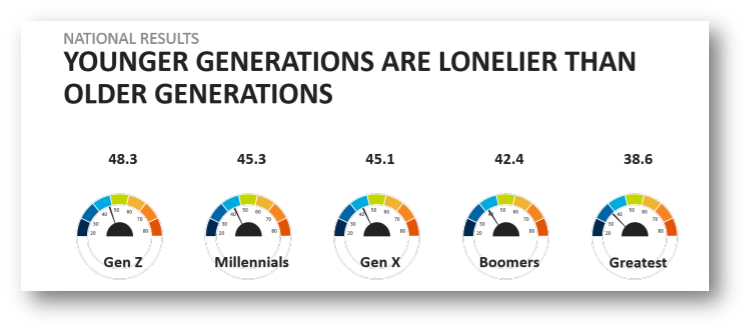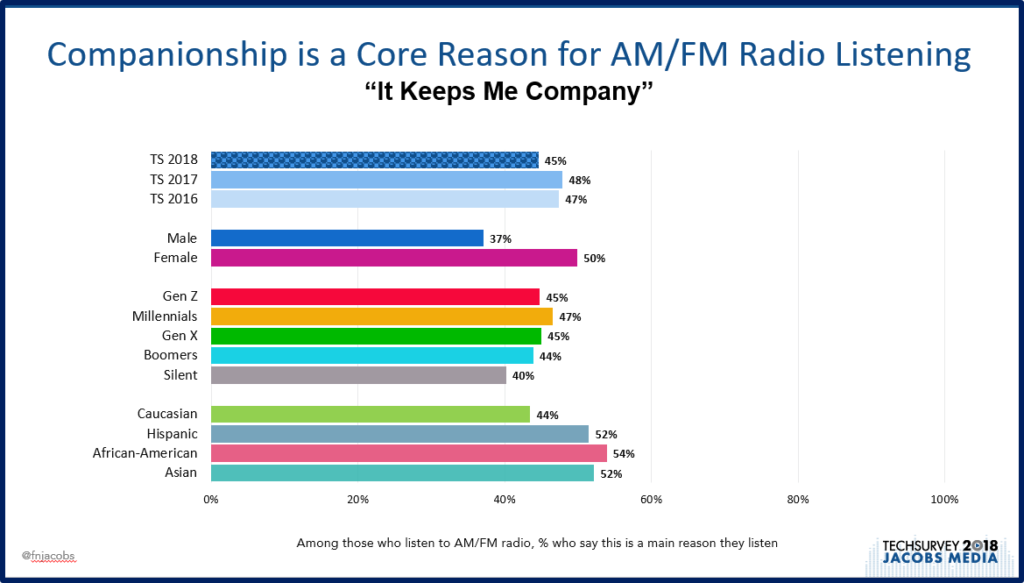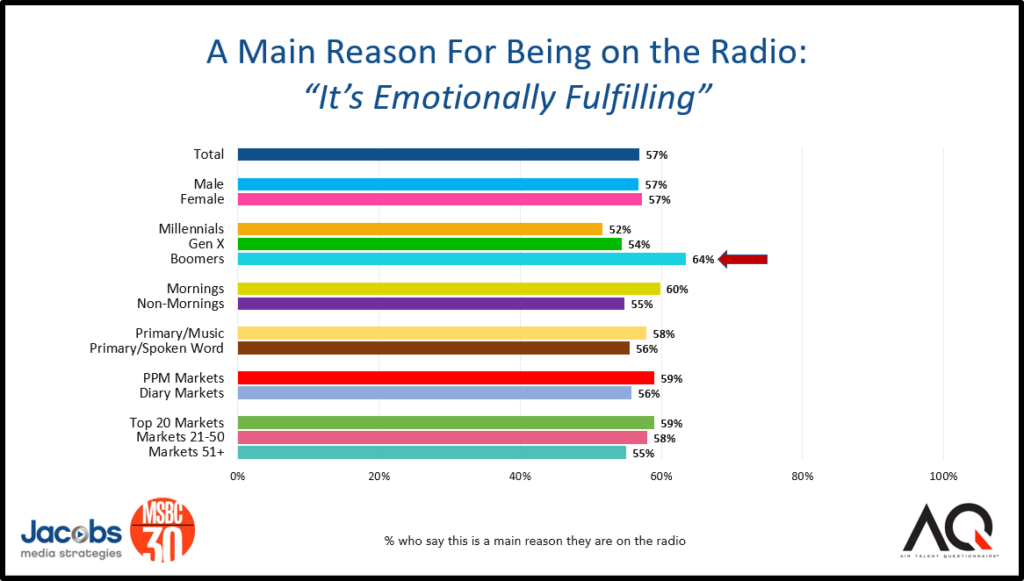
One.
It’s the loneliest number. And I’ve been thinking about that as we rush headlong into the holidays, a time when most people are united with their families – for better or worse.
An opinion piece in last Sunday’s New York Times has been haunting me all week. Written by the president of the American Enterprise Institute, Arthur C. Brooks, the headline is a grabber:
“How Loneliness Is Tearing America Apart”
Brooks cites a Cigna survey published last May – the health care provider’s “Loneliness Index,” measuring the behavior of 20,000 Americans. It turns out the youngest respondents – members of Gen Z and Millennials – exhibit the most loneliness. On the chart below, the higher the number, the greater the level of despondency:

And there was no big difference between the despondency expressed by men and women.
But the generational spread is interesting – and certainly open to interpretation. You might make the case these younger groups are also the most immersed in social media. So, is that a driver?
Apparently not, according to Cigna. In fact, there’s not much difference in loneliness between very heavy and light social media users.
But a lack of human interaction, less time spent with family, a lack of exercise and unbalanced sleeping patterns are all factors that contribute to states of loneliness.
Perhaps, so is listening to the radio. No, Cigna didn’t ask that question, but we do every year in Techsurvey. Our “Why radio?” question series has become much quoted in industry trades and beyond.
And when you dig deeper into the data, you glean even greater insights about the value consumers place in the radio they listen to. We give respondents a long list of potential reasons for enjoying listening to their favorite AM and FM stations, and they tell which ones are the most important.
While music and personalities are obviously key factors – so is companionship.
In fact, nearly half (45%) of our 64,000+ respondents tell us a main reason that factors into the equation is that “Radio keeps me company.”

Note that Millennials skew higher, as do Hispanics, African Americans, and Asian respondents. And women are far more likely to turn to radio for companionship than men.
The Cigna study – and this Techsurvey chart – conjured up memories of perhaps the best on-air talent I ever encountered when it came to providing comfort, solace, and true love for his listeners – most of whom were women.
Alan Almond ruled the airwaves here in Detroit at WNIC with his Pillow Talk show. Alan passed away in 2015, but I interviewed him earlier that year for our “Radio’s Most Innovative” feature. Alan’s show was brilliant, insightful, and smart. Part of the hook was that he was never seen by the audience – in person, in public, or in press kits. He walked into the studio every night, turned the lights down low – and kept thousands of Detroit women company during good times and bad.
And there was nothing gimmicky about the way Alan Almond connected with his audience. Here’s how he thought of them and catered to them night after night, year after year:
“I talked to that one person… I was talking directly to that one woman driving home from work, the one girl lying in bed at night… I was talking to one person and I kept it there.”
Not the loneliest number.
While not as stylized as Pillow Talk thousands of air personalities throughout the country – and the world – provide a sense of companionship to commuters every day. Driving in a car or truck is still one of the last bastions of privacy – where people can be by themselves, deep in their own thoughts, rocketing down freeways, backroads, suburban streets, and two-lane highways.
And there’s nothing more personal than a DJ or host speaking directly to that driver. It’s an intimate relationship between a personality and a consumer – one unlike any other medium shares with its audience. Clearly that unique environment is a contributing factor in cementing a bond – where radio provides a sense of companionship as we motor to work, back home again, schlep kids, and run errands.
It’s one of the factors that separates a savvy, gifted radio personality from playlist services and even satellite radio (which always sounds distant no matter how hard they try). Local talent provide a sense of place, empathy, and understanding. They feel the frustration of the first snow storm, the angst trying to get to work on time, the stress navigating through the maze of rush hour traffic, and the tension that goes with the fine art of parking a minivan at a crowded mall. And the really good ones become part of the family.
So, perhaps we shouldn’t be surprised that a key reason why radio personalities love being on the air is this:
“It’s emotionally fulfilling.”
We heard this loud and clear in AQ, our study of more than 1,100 radio personalities conducted earlier this year in partnership with Morning Show Boot Camp.

As you can see, it’s up and down the board, in big markets and small ones, whether they’re measured by meters or diaries, and regardless of daypart. And interestingly, those who have been at it the longest – Baby Boomer DJs – are even more likely to cite emotional fulfillment as a key driver for why they relish being on the air.
I actually heard this the other morning while driving through rural Wisconsin. I was able to pull in Tom Barnard, morning icon at KQRS in Minneapolis. If you’ve listened to Tom, you know he has a trademark gruff, in your face quality that has made him dominant in the Twin Cities for decades.
But that’s the exterior. Inside, Tom is one of the warmest, most caring people who has spent time behind a mic. During an interview with a 12 year-old kid in Gilbert, Arizona (a suburb of Phoenix), Jayce, who has created with his brother Lincoln, an organization designed to make people feel good – “Random Hats of Kindness” – Tom came out the winner:
It’s more evidence that emotional rescues work in both directions, something those of us who love radio know so well.
The holidays are an especially emotional time for so many people – the perfect occasion for connecting with audiences especially in need of warmth, empathy, and companionship.
When listening to the radio, one is not the loneliest number.
Special thanks to Rob Thorson & Scott Jameson.
- Can Radio Afford To Miss The Short Videos Boat? - April 22, 2025
- Media And Technology In 2025: Believe It Or Not! - April 18, 2025
- In Radio, You Just Never Know - April 17, 2025




What a great example of radio’s ability to provide intimate human companionship and create meaningful emotional experiences. Though I must ask, how many classic rock PD’s and GM’s would get excited and support their morning show if it came to them with the idea of doing a 16 minute break about a 13 year old kid selling hats promoting random acts of kindness. Sadly, I think there’d be a lot of, “I don’t think our target audience will give a s*** about that,” unless of course, the morning guy is Tom Barnard or Howard Stern.
Bill, I hear you. So how do you become a Howard Stern or a Tom Barnard? Part of it that you need running room. But you also have to earn the ability to pull off a 16 minute break. It’s notable that Tom has always played music on his show – just enough to remind you you’re listening to a Classic Rock station. But it’s also about winning the audience’s trust. Tom’s audience knows he won’t waste their time with frivolous content and blathering. That’s a big part of our post this morning. Let me know what you think & thanks for the comment.